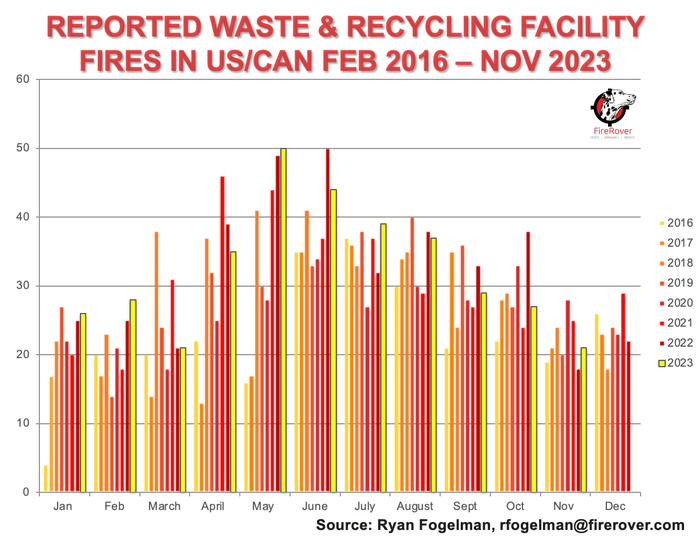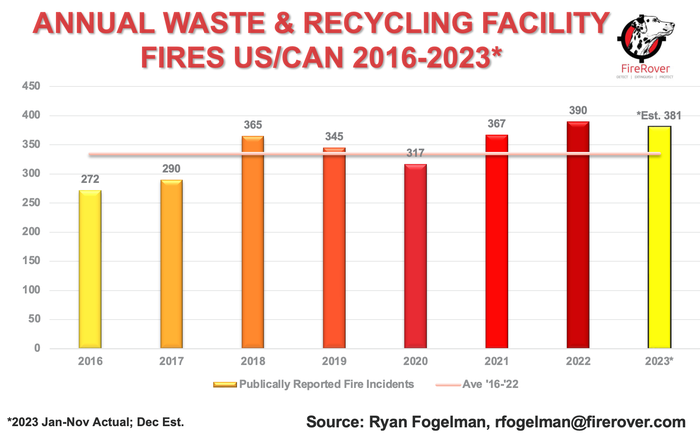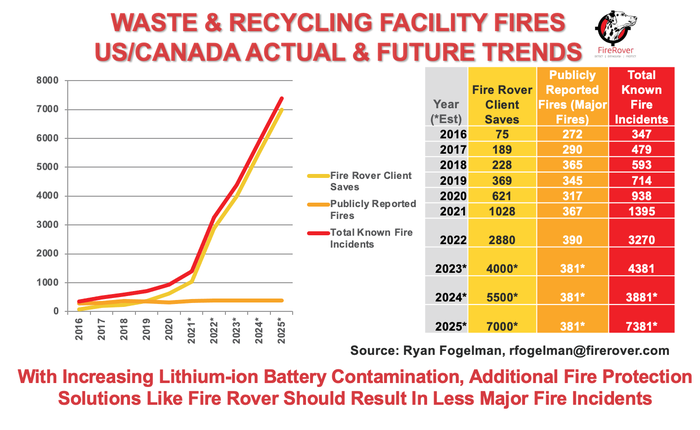What is “Real Recycling?”
Ryan Fogelman highlights a misconception among Americans that their recyclables, such as aluminum cans and paper, contribute significantly to recycling efforts when, in reality, they make up less than 10 percent of the total tonnage that gets recycled.

As we approach 2024, the rearview mirror is finally coming into focus. Barring a big December, forecasted fires are 381 heading into the last month of the year. The good news is the number is trending down from the 390 reported fires we experienced in our waste and recycling facilities in 2022, our worst year of reported fires since I began reporting in 2016. Will my hypothesis regarding the effectiveness of the Fire Rover solution and the protection of a growing install base finally turn the tide of increasing fires we have become used to? As we get a handle on these fires, it will provide an opportune time to combat the public’s perception of the waste and recycling industry as a dirty, smelly, fire-prone nuisance to society as opposed to the “real recyclers” that we are.
November 2023 Fire Data
In November, we encountered 21 publicly reported fire incidents at our waste and recycling facilities. Of those incidents, 11 occurred at waste, paper and plastic facilities, four occurred at scrap metal recycling facilities, four occurred at organics facilities, one occurred at an electronic battery recycling operation and one occurred at a hazardous material operation. At Fire Rover, we responded to 300-plus hot spots and/or fire incidents at our clients’ facilities.

In the past 12 months, we have experienced 379 unique reported fire incidents, and based on reasonable assumptions, we can extrapolate that 2,400-plus facility fires have occurred in the past 12 months in the U.S. and Canada. During that time, we also have experienced 75 reported injuries and two deaths.

Based on these numbers, I have re-estimated the forecast for this year's guidance. Barring any crazy outliner, we should come in lower than last year's 390 reported incidents. We have experienced 357 reported incidents in the first 11 months of the year. Using a simple average of the past seven years would yield 24 incidents, which added to 357 equates to my estimation of 381.

Will My Hypothesis Come True?
Those of you who know me know my goal has always been to solve the “fire problem” in waste and recycling facilities in the U.S. and Canada—and now Australia, New Zealand, France and the UK. I have been sharing this in my articles since 2016. The idea is simple: As we continue to successfully protect our customers' facilities with “Fire Rover client saves” and grow our install base, we will have more Fire Rover client saves, so the number of “reported fires” will start to decline. The result is more “known fire incidents” but less reported fires.
As an industry, I believe we are on the right track. It might have taken three more years than I predicted, but I am hoping we are officially at the point where all the industry’s hard work, investment in operational best practices, investment in fire protection and more is starting to pay off.
We are in the process of the final installation of a new state-of-the-art fire system at one of the world’s largest battery recyclers. The system combines a 250,000-gallon water tank, a 10,000-gallon tank and inductor of an environmentally friendly encapsulator agent, 107 detection zones and 57 remote controlled nozzles.
As we get better control of these fires, we can also combat the public’s negative perception of the waste and recycling industry and showcase the good work we do each day to keep the environment safe and clean.
What is “Real Recycling?”
Check out the video below. If you know what I mean, you are typically “in the business.” “Real recycling” is primarily made up of the construction and demolition (C&D) sector combined with scrap metal (ferrous and non-ferrous metal processing).
Let me put this into perspective.

(Source: https://www.epa.gov/sites/default/files/2020-03/documents/final_cd-eol-management_2015_508.pdf)
As you can see, the scrap and C&D markets make up more than 1,500,000,000 tons recycled annually in the U.S., whereas MSW recycling only accounts for less than 100,000,000 tons annually.
I would be happy to take odds on how many Americans actually understand that their recyclables such as aluminum cans and paper make up less than 10% of the total tonnage that gets recycled versus getting tossed into a landfill to rot for eternity. The reality is the places the public thinks are hazardous are doing the heavy lifting for the “recycling/reuse movement.”
I want to be clear that I am in no way saying MSW recycling is not important to the world. It is hard to argue that throwing something away that could be used again or used as recycled material is one of the most important things we can do for humanity. However, the perception of real recycling must be taught to our children, the public, government entities and changemakers across the county.
How Do We Change the Public Perception of Recycling?
We can start by sharing the fact that the scrap and C&D industries are doing the heavy lifting, and we, as the public, need to continue to participate by bringing the MSW recycling rates to as high of a level as we can. To do this, we must recycle properly, reduce contamination and prevent the high cost of bad recycling or issues like batteries invading the waste and recycling streams.

I can imagine the campaigns now. Do you see this noisy neighbor over there with the shredder? They are responsible for recycling almost 70% of all the material being reused for another purpose. We know you don’t love them as neighbors, but they are there for the “public good.” Most C&D material is processed onsite, like the video above, and is located in every area of the country. Then that material is shipped to the proper facility for processing and sale.
This is not a new phenomenon either. These recyclers have been hard at work for almost a century in some way, shape or form, keeping material out of our landfills. In America, when there is material value, I can assure you someone will find a way to turn it into a profitable business.
There are some amazing industry influencers like John Sacco from Sierra, Brett Ekart from United Metals, Jennifer Betts from Recycled Media, Michael Goldstein from Alter and others who are driving this agenda for the industry. But we need more help, so we need the proverbial gasoline to throw on this fire. We need dollars for education and to work with journalists to understand the real problem and opportunity so we all understand the full story. We need to all be telling the same story and sharing it on our social and business channels.
And the real hope is that if the public understands what real recycling is, more attention will be paid and dollars will be invested in technologies, old and new, to help drive a better overall understanding of our industry’s benefits. This should ultimately result in a better reputation due to the negative perception we have allowed to continue for this long.
Conclusion
Last month, I was fortunate to speak at the 2023 Michigan Great Lakes Solid Waste Association of North America Annual Membership Meeting. I was asked by the president and now past president, Paul T. Sgriccia, P.E., to speak about Fire Rover at this event. Since I am based in Ohio, I did not know who was going to show up to the event, but I was pleasantly surprised that two of my longtime customers, Brad Austin and Mike Csapo, were in attendance. The presentation turned into an in-depth discussion on the ins and outs of our solution and the ways our customers use our solution to its greatest functionality for this specific operation. If you have some time and interest, I have posted the full conversation below.
As we head toward the holiday, I am beginning to work on my 2024 Annual Report, where I take a deep dive into the 2023 data including the reported facilities fires in the U.S. and Canada as well as the full report card for our Fire Rover solutions.
I’m happy to share that in November, we hit a significant milestone of 500 systems installed across the globe, which, along with our performance, should help bring the industry closer to no more major fires at our waste and recycling facilities around the world!
This is a large milestone to celebrate this holiday season, and I can’t wait to continue making the industry a safer place to work in 2024.
Ryan Fogelman, JD/MBA, is vice president of strategic partnerships for Fire Rover. He is focused on bringing innovative safety solutions to market, and two of his solutions have won the distinguished Edison Innovation Award for Industrial Safety and Consumer Products. He has been compiling and publishing the “Reported Waste & Recycling Facility Fires In The US/CAN” since February 2016 and the “Waste & Recycling Facility Fires Annual Report.” Fogelman regularly speaks on the topic of the scope of fire problems facing the waste and recycling industries, early detection solutions, proper fire planning and early-stage fire risk mitigation. Additionally, Fogelman is on the National Fire Protection Association’s Technical Committee for Hazard Materials. (Connect with Ryan on LinkedIn at https://www.linkedin.com/in/ryanjayfogelman or email at [email protected])
About the Author
You May Also Like




.png?width=300&auto=webp&quality=80&disable=upscale)